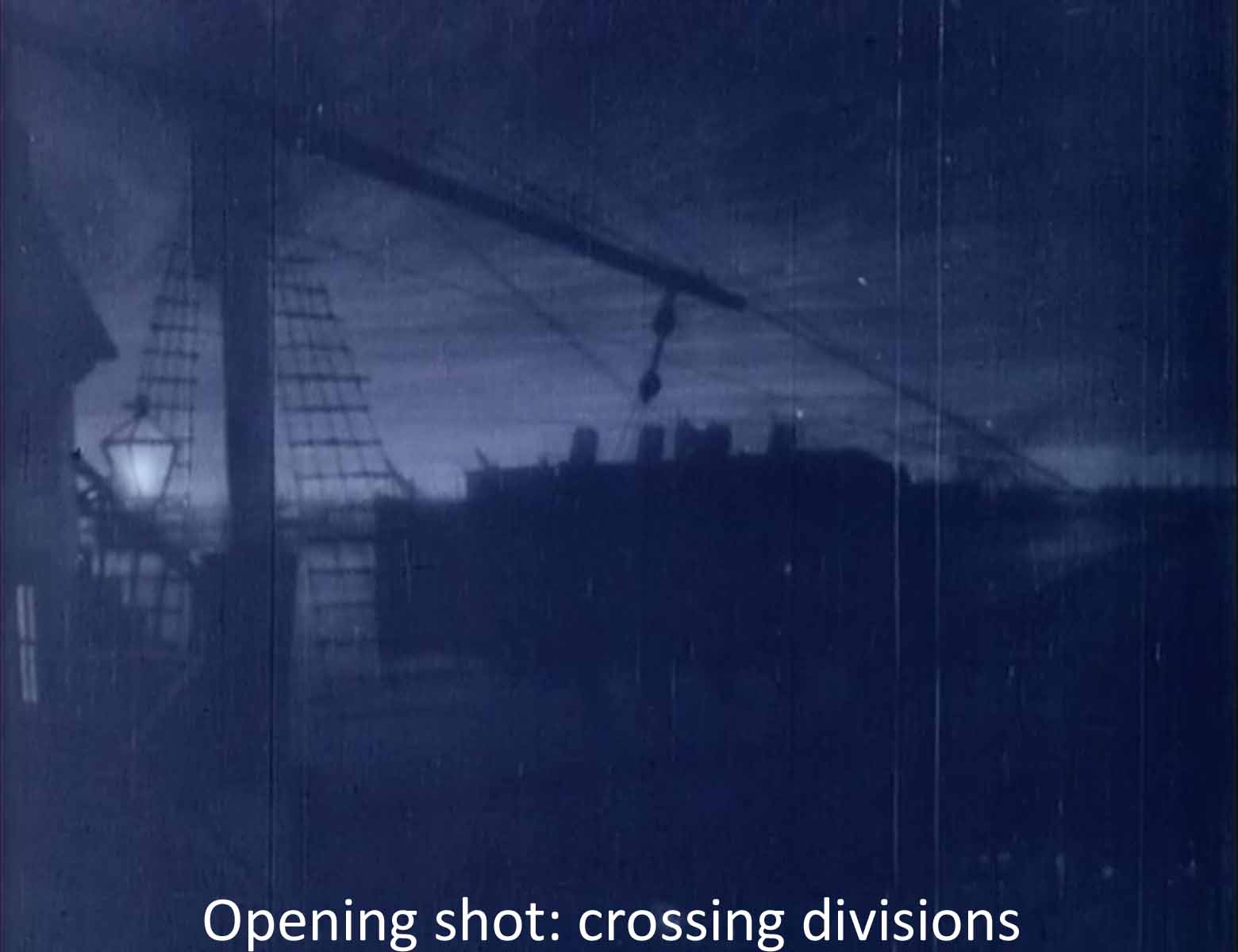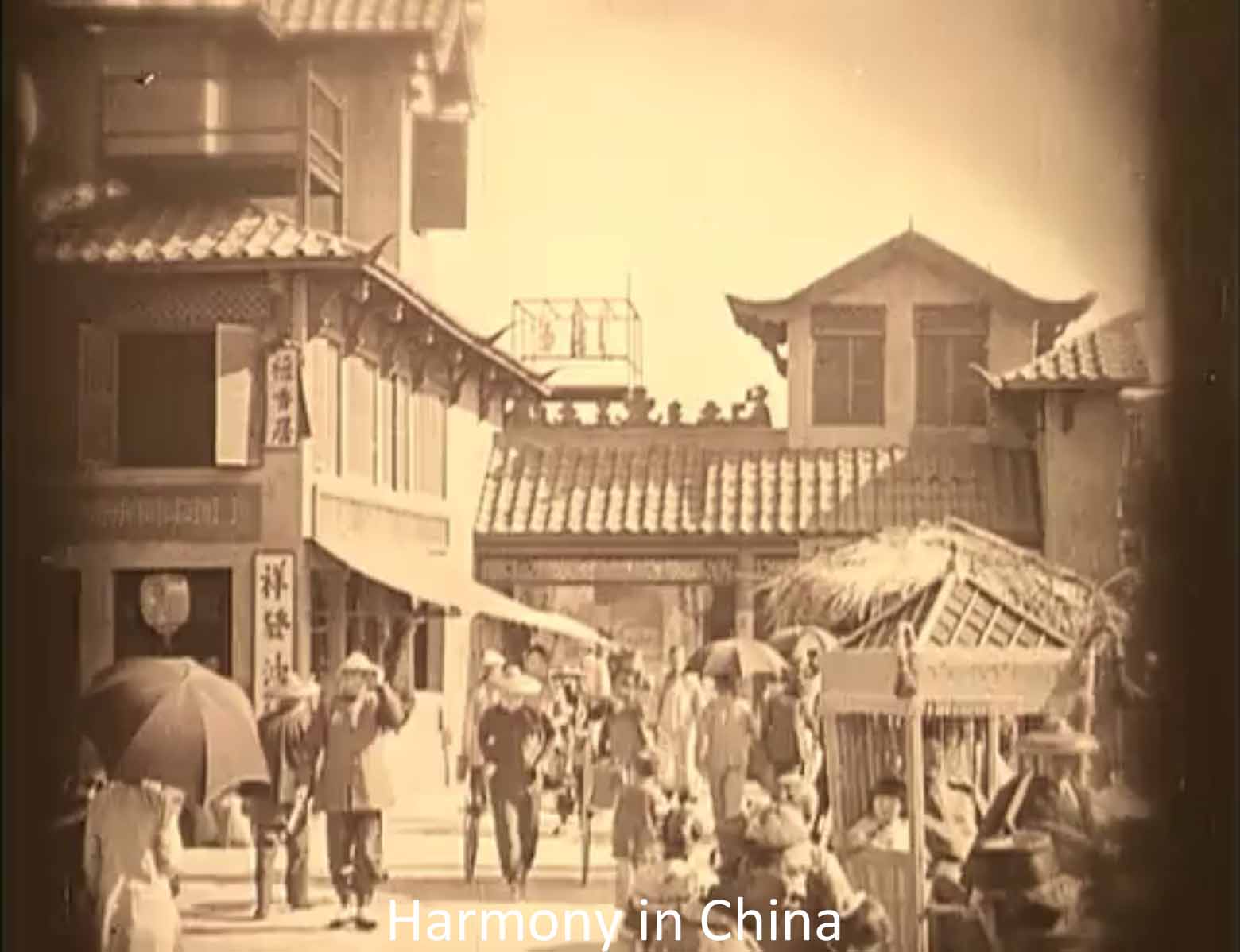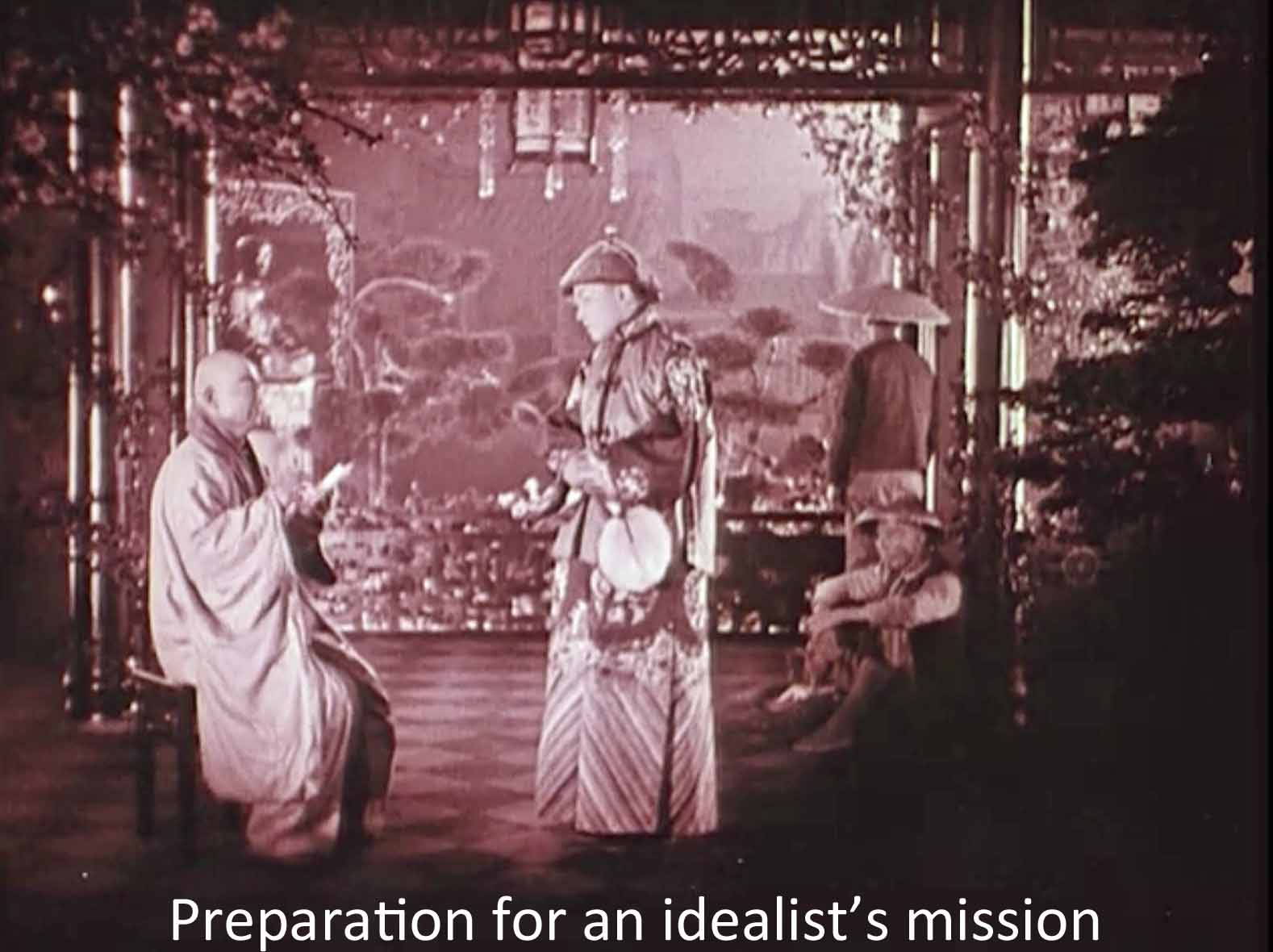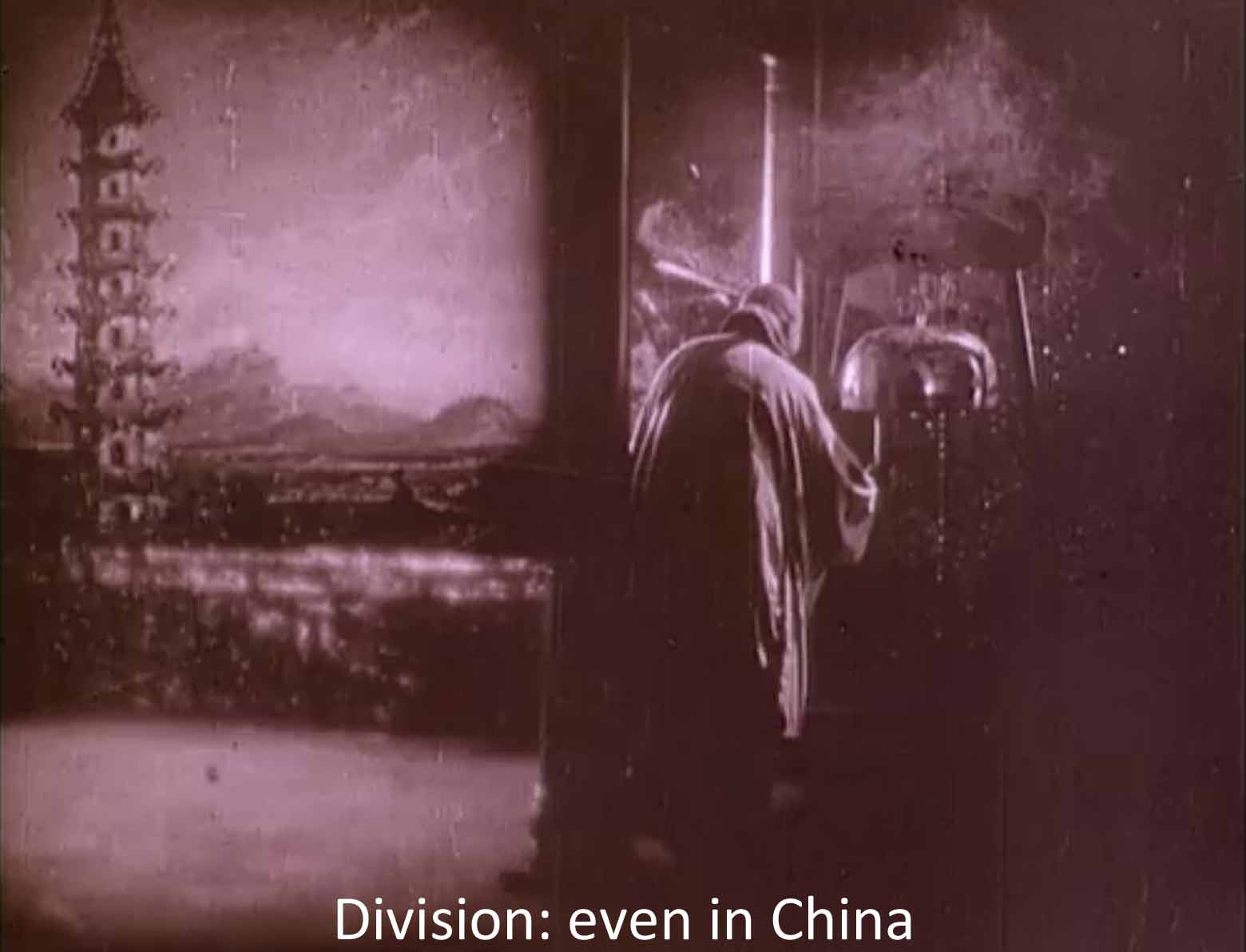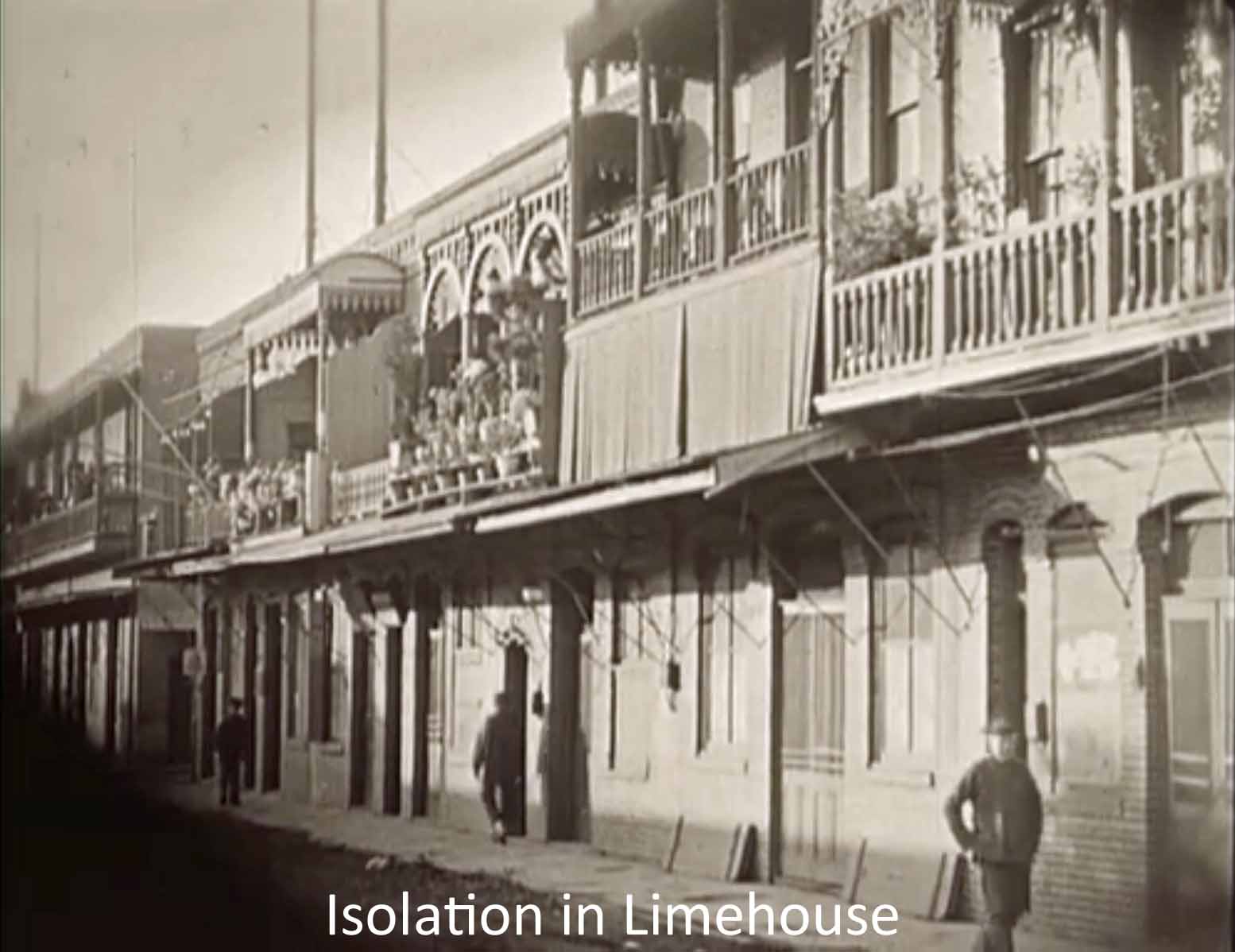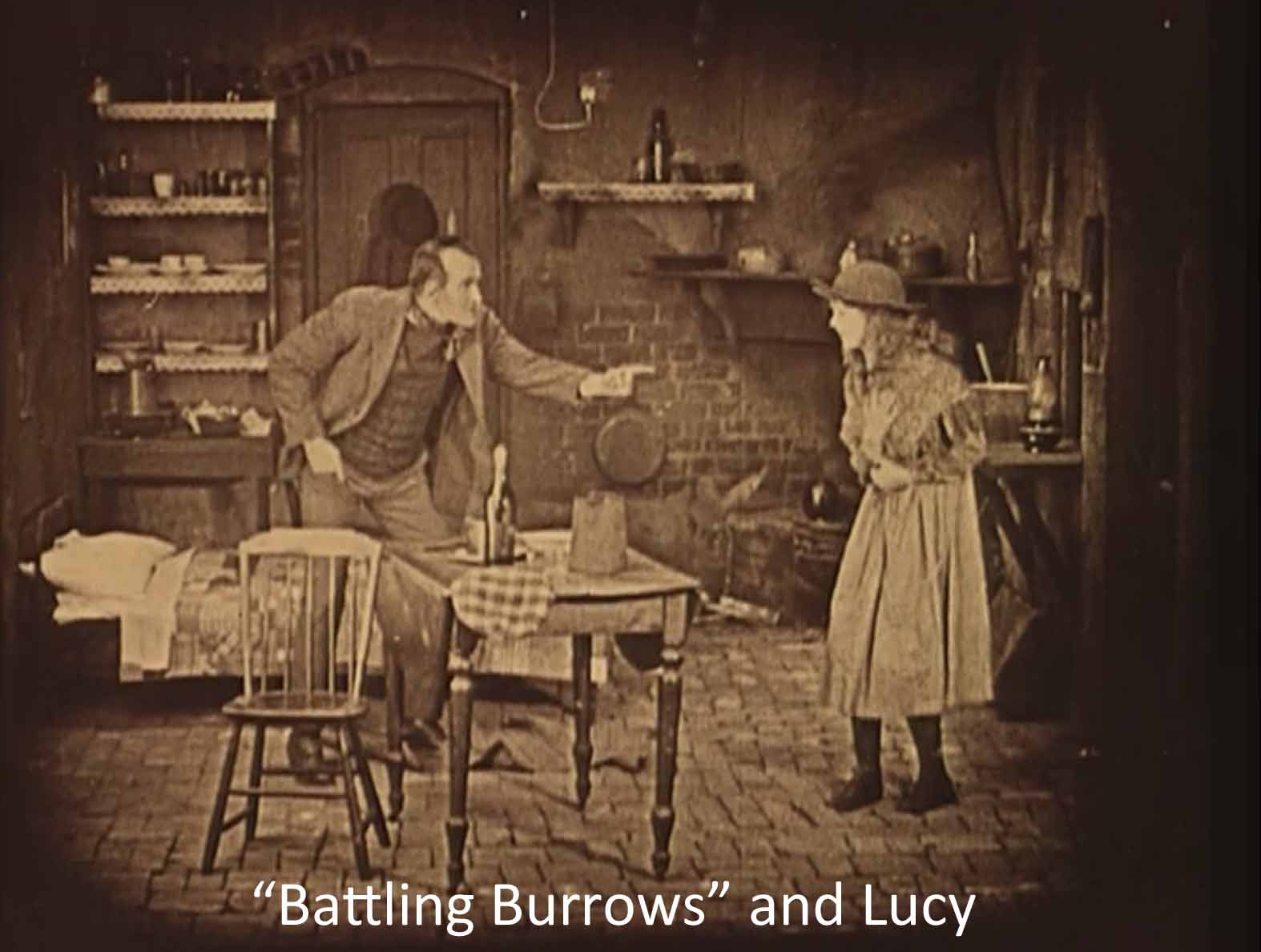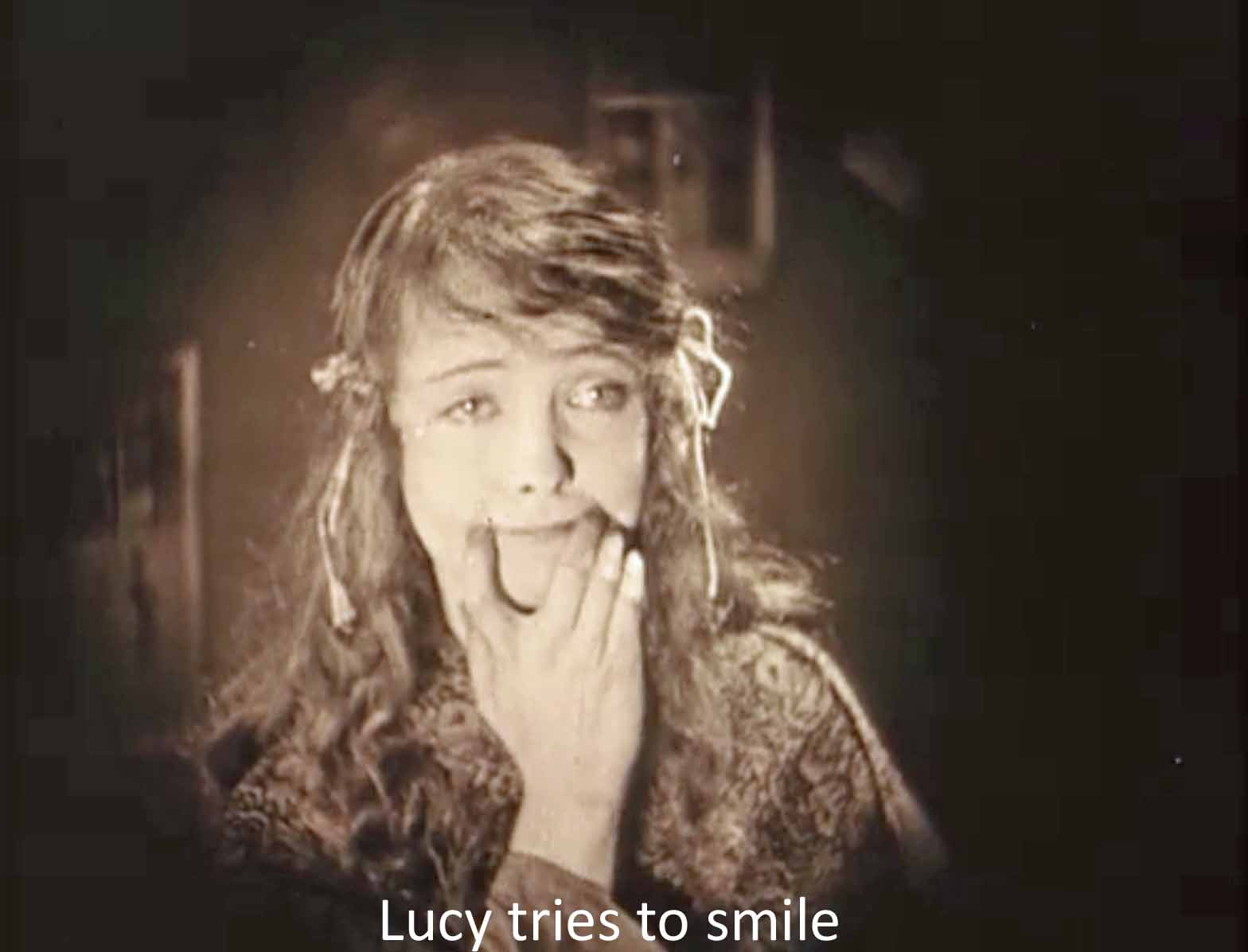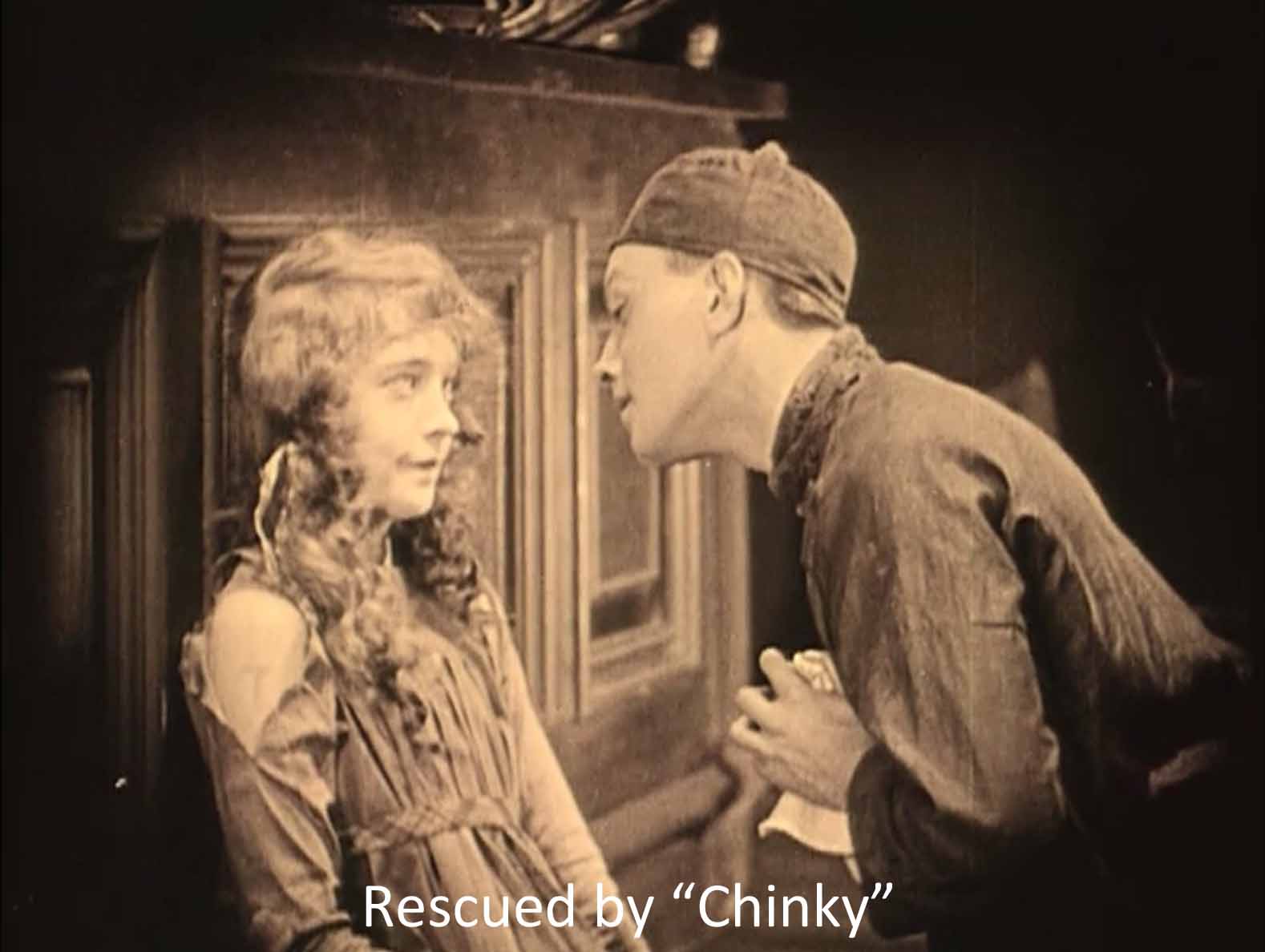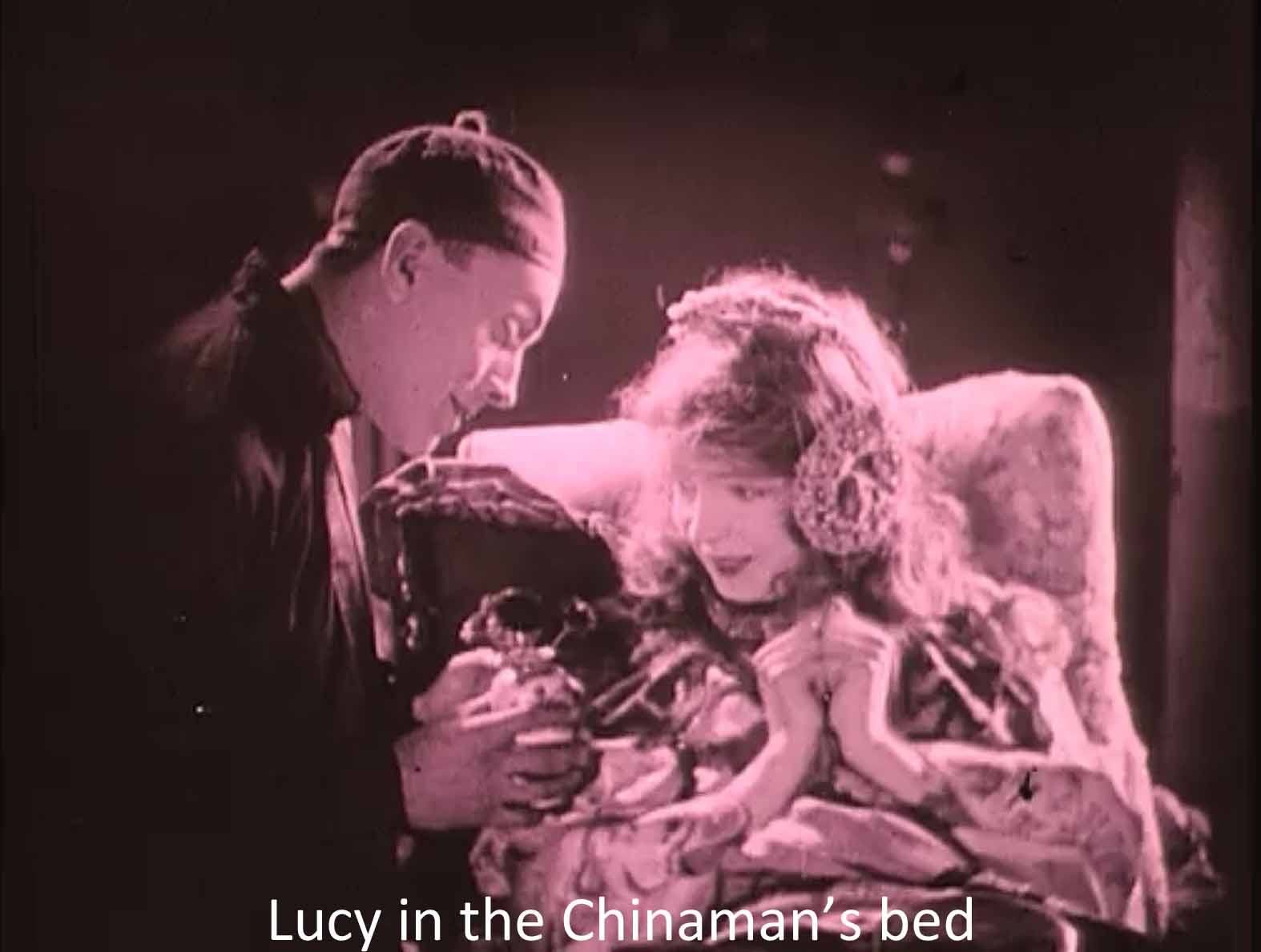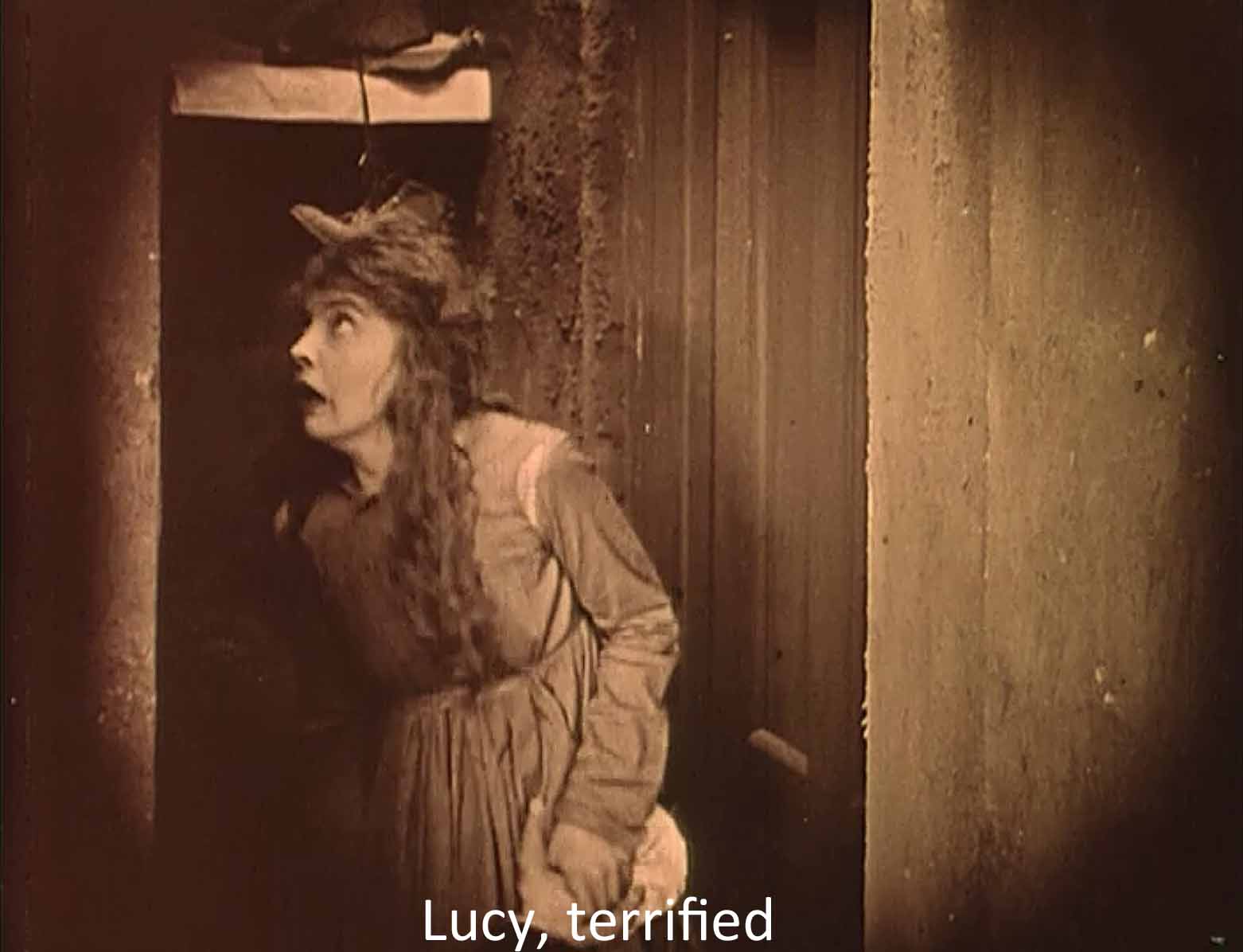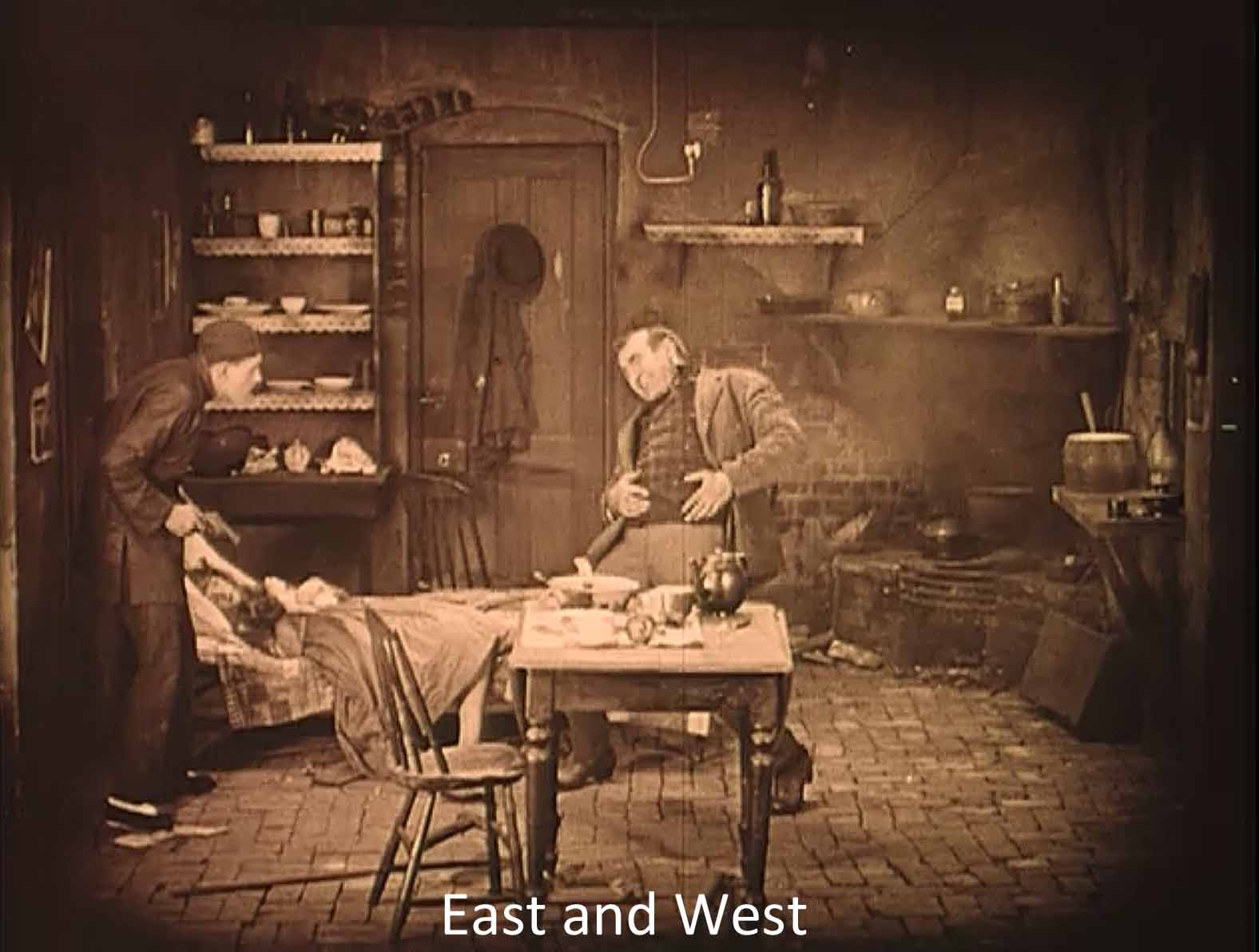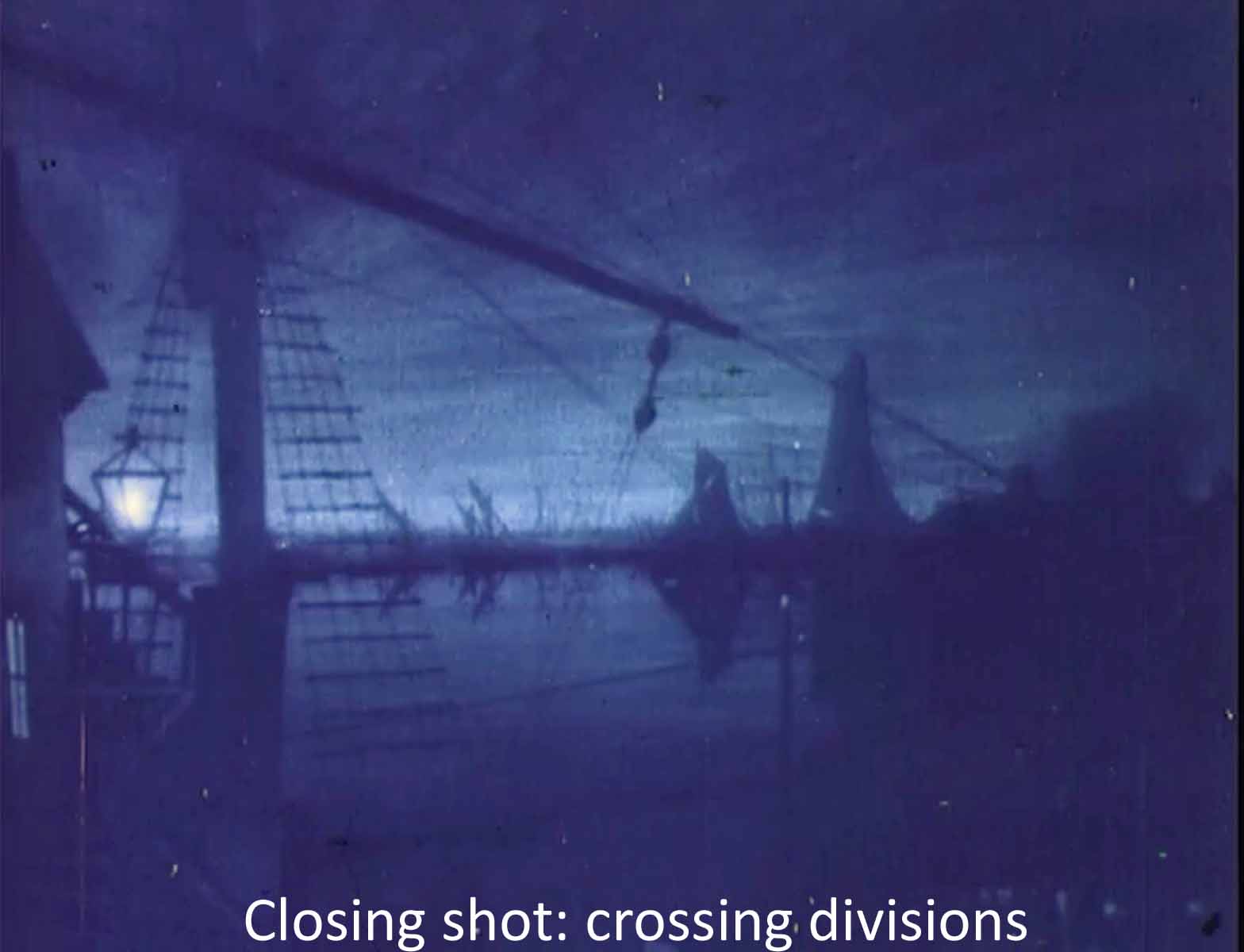The opening shots show a peaceful Chinese port where people of all ages and nationalities mingle in harmony. Piggish American sailors contrast to the Chinese bestowing coins on children. In a Buddhist temple, we meet our hero, Cheng Huan (Richard Bathelmess), a well-to-do, richly gowned Chinese. He wants to bring the Buddha’s message of peace to the West, and he prepares himself in the temple for departure. Cheng makes the mistake of intervening in a fight between the American sailors and gets knocked down for his trouble.
Some years later, however, we see him as a dispirited shopkeeper, hanging around the opium dens of Limehouse. Curiously, Griffith uses what one might call flash present (as opposed to flashback or flashforward) as he muses on his present existence: a brothel, an opium den, a gambling table where he again intervenes in a fight.
Also living in Limehouse are the prizefighter Battling Burrows (Donald Crisp), a brute with a permanent scowl, and his pathetic daughter Lucy (Lillian Gish) who drifts aimlessly around the docks, hunched over as if expecting a blow. She is perhaps fourteen, halfway between girl and woman. Burrows bullies her cruelly (and to an eye of today, she was probably sexually abused as well as emotionally and physically beaten). Griffith gives her, like Cheng, two flash presents. A married woman, beset with many children (no Planned Parenthood here!) and a brutal husband tells her not to get married. Two prostitutes warn her off their trade too. Those are the only two choices for the women of Limehouse.
When she returns to Burrows’ slum, he yells at her and forces her to smile at him. So downtrodden is she that she cannot smile from inside, but has to push the corners of her mouth up with her fingers. He makes her wait on him as he piggishly eats (echoing the American sailors in China).
When Burrows leaves, we return to Cheng. Two passing missionaries tell him one of them is going to China to “convert the heathen.” They give him a tract on Hell—hardly needed in Limehouse.
Lucy digs out her few treasures that she has hidden under a brick, a hunk of tin foil, a letter and a ribbon from her non-existent mother. She goes out to shop, pathetically trying to buy a flower with the tin foil, but she doesn’t have enough. Cheng, seeing her, falls in love with her and rescues her from the blandishments of another Chinese, Evil Eye.
Meanwhile, Battling’s manager finds him in a saloon and insists again that he give up drinking and whoring. In a rage he goes home—no Lucy. When she does come, he takes his fury out on her for not having his tea on the table as soon as he demands. Because some hot food spills on his hand (his own fault), he takes out a whip and beats her, then goes off to train for his next fight.
Dazed, she wanders the streets and collapses into Cheng Huan’s shop. He tenderly carries her upstairs and innocently expresses his chaste love for her by putting her to bed with flowers and a doll and a beautiful Chinese robe. Twice he seems about to kiss her but pulls back. One of Battling Burrows’s buddies, however, spies her there and tells the fighter who furiously vows to avenge his honor.
He wins his fight and, finding Lucy alone in bed at the Chinaman’s, Cheng having gone out, he tears her away and smashes up the bower Cheng Huan has created. He drags her off to their hovel. There he drags her out of the closet to which she has fled (Gish’s acting reaches a peak here), and he beats her to death with the butt end of his whip. Evil Eye tells Cheng Huan what has happened. He rushes to Battling Burrows’ hovel, finds the dead Lucy, and the two men confront each other. Cheng Huan shoots Burrows, carries Lucy back to the bower, and stabs himself. The man of peace becomes a killer. The final shots are of a peaceful China in soft focus—but curious shots they are: a vertically halved picture of a temple and the harbor; a horizontally halved picture of junks on the water.
The temple-harbor shot echoes the same shot from before Cheng’s departure, as if to say division is a fact of life and will not change. The shot of the slowly moving junks perhaps suggests that the effort to surpass the divisions will also go on and on and on. Griffith had added the Danish cinematographer Hendrik Sartov to Billy Bitzer who had done so many of his Biograph pictures with him. Bitzer was not pleased, but Sartov added novel cinematic touches: close-ups and soft focus (listed in the credits as “special effects”).
Like the divisions of those final shots, the film builds on extreme contrasts: East and West, Asian and Anglo, Buddhism and Christianity, opium and whisky, Cheng Huan and Battling Burrows, the man of peace and the man of fighting, the brute and the innocent girl. Battling Burrows’ spy discovers Lucy because she drops a cup—breaks china (in a not too innocent pun), leaving it with sharp edges. The film makes division its basic premise.
The division cuts across its two basic symbols: hands and flowers. We see gentle hands in China and with Cheng Huan. We see Lucy wring her hands constantly. Battler’s hands, of course, are brutal weapons. Lucy uses her fingers (and later a doll’s hands) to force a smile, acting out the way force pervades everything in the violent West. Cheng and even Evil Eye linger with flowers, symbol for the gentleness Griffith associates with the East. None of the Westerners have anything to do with flowers—except for Battling Burrows who has a cauliflower ear (another none too innocent visual-verbal pun). And he angrily says to his manager who is telling him to reform, “Wot yer want me to do—pick violets?”
In the same simplistic division, the camera work pairs off different styles. It moves very slowly for Lucy’s painful walking or shopping, and it races along for Battling Burrows’s aggressive strut. (Indeed Lucy and Battling Burrows argue about time: he says the tea is late while she cries, “’Taint five! ’Taint five!”) Matching this contrast in pace is the contrast between incredibly soft-focus, misty, impressionistic scenes of China or the Limehouse docks or Cheng Huan’s adoration contrasted to ordinary sharp-focus, reportorial shots of, say, Battling Burrows’ prizefight. “Atmospheric” deep shots contrast to flat on, proscenium arch scenes. The film is tinted, part pink, part yellow, part ordinary black-and-white, associated with different contexts.
The contrast that cuts the film down the middle is Limehouse against the Chinese port from which Cheng Huan comes. Limehouse provides an atmosphere of violence and conflict. There, the police, reading a newspaper, are pleased that there are “only” 40,000 casualties this week as opposed to (how many?) last week. (Evidently, the movie takes place during World War I, since Battling Burrows fights in front of the munitions workers.) In Limehouse, the clergy preach “Hell,” as opposed to the Chinese priests who give loving, fatherly advice. Western sailors fight in the Chinese port. The priest’s holy gong in the Chinese temple recurs as the tiny bell in Cheng’s household shrine and the much larger referee’s gong in Battling’s prizefight, singled out by Griffith’s closeups.
China otherwise offers an atmosphere of merged and resolved differences. Men and women, old and young, sailors and natives mingle on the streets, which are crowded and lively, as opposed to Limehouse where the streets are mostly empty. People are either inside, in bars or opium dens, or furtively walking, stooped over. There are no more than two or three people on the streets at a time. Walls, curbs, posts, and archways define boundaries.
There is a parallel contrast in the ways the East and West respond to the feminine. Young girls in the Chinese scene get their futures foretold—they have a future. In Limehouse, scenes specially inset by Griffith show the miseries of one wife and two prostitutes. These are the only two possibilities for women in Limehouse, and both the wife and the prostitutes say, Don’t do it. When Battling Burrows kills Lucy, he tears her out of a closet, as if to root out the feminine.
Aside from her, the plot has only one other woman, the boxer’s disreputable girlfriend, and his manager tries to get Battling Burrows to put her aside. Motherhood, for Lucy lives, in effect, under a brick. The first shot of Lucy shows her walking past a man who stares out at the water, smoking his pipe, ignoring her. Limehouse—the West—is very distinctly a man’s world, and the men confine and use and attack the women. There is no place for the feminine in Limehouse.
The early shots in the Chinese port, however, show men and women together, the men wearing gowns. Three schoolgirls stroll happily and consult a fortune teller (unlike the wife and the prostitutes in Limehouse who have no possibility of good fortune). An old man gives money to little girls and their mother. In general, it is a society that is comfortable with the feminine.
Cheng Huan’s aim—and the aim of the movie, to judge from its soft-focus, painterly “art” shots—is to break down these harsh contrasts, to resolve conflicts, and to create a between-ness. Cheng intervenes four times in the film, between the fighting sailors, between the squabbling gamblers, between Lucy and Evil Eye, between Lucy and an offstage Battling Burrows. Further, he is a “yellow man” according to the title, with perhaps implications of cowardice. Certainly he is no match for the “gorilla” Battling Burrows. Cheng Huan is a master at things a macho society restricts to the feminine: flowers, china, dresses and dress materials, the flute and music, poetry, moonbeams. Indeed, when he pantomimes scooping up moonbeams from the bedroom floor and scattering them over Lucy’s head, he is carrying out one of the commedia dell’arte’s standard routines for the loving, moonstruck Pierrot. His costume looks like a Pierrot’s (like Baptiste’s in Les Enfants du Paradis [Carné, 1945]), but Cheng’s is dark, not white as befits his tragic status.
Overall, the film acts to cross these divisions. The Chinese comes to London. Blurred ships cross a post-Impressionist water (in soft-focus shots of the Chinese port but also the Thames). Battling Burrows crosses the river to train for his fight, leaving Lucy alone to be found by her lover. The yellow man crosses a taboo against the white girl. The man of peace becomes a killer. The film associates images of water and mist and ships moving on water with these various crossings and mergings and resolutions.
In effect, the film at first viewing seems to aspire to peace and mellowness. The film wants to dissolve the conflicts or contrasts or boundaries of the Limehouse world (as in the soft-focus boats of the last shot), but that doesn’t happen. Instead, contrast (the yellow man, the Oriental) begets conflict—the double murder and suicide or, in the next to last shot, the sharply divided picture of the Buddhist priest on land in his temple and the open waters of the harbor.
Whatever Griffith hoped for (perhaps by adding the new cinematographer), I think the film images a failure to soften a world of contrasts and conflicts into a world of no contrasts and no conflicts. Indeed, the opposite happens; we end with conflict. In the film’s metaphor, china is broken—given sharp edges.
A side interest to me is the way I find that theme at the heart of American cinema. I don’t mean race, although this film is subtly racist. I do mean that Griffith’s sentimentality makes a central point about the American filmmaker. Not that the classic American films are all sentimental—they aren’t. But they do mostly render the world in exaggerated, even childish contrasts of good and evil, black and white, fast and slow, masculine and feminine, cowboys and Indians, cops and robbers. While such boyish contrasts lend themselves to a sentimentality like Griffith’s, they also provide the base for the Western, the gangster film, the detective story, the film noir, the screwball comedy, the monster movie, and the other much more sophisticated classic American genres. The world of the American film is a world built on the straightforward distinctions of myth and legend. Such black-and-white films have their own artistic virtues, which are not to be compared with the complex, realistic, interpersonal greys of the classical European film artists. These myths, built on extremely simple contrasts, are the product of an indigenous popular culture which has its own difficulties with the feminine, with dependency, and with the subtler distinctions of human relations. In effect, Griffith, in sounding his own sentimental tremulo, also sounded a keynote of all American film, even the most unsentimental.
